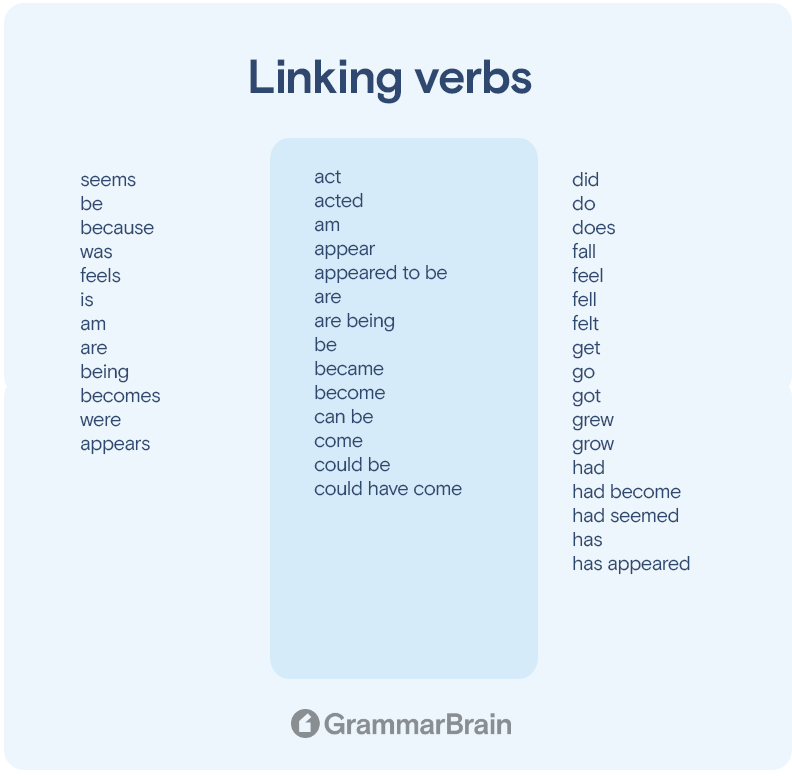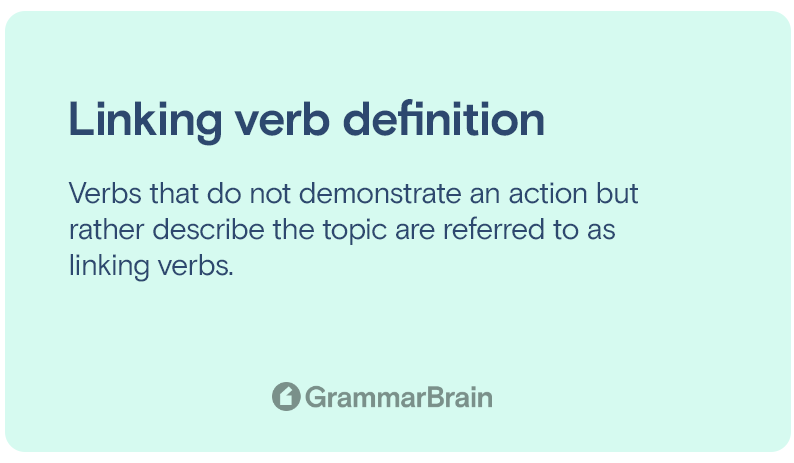Linking verbs are a type of verb form that connects a subject of a sentence to an adjective, noun, or pronoun. It helps to complete the meaning of the verb. These include the verb forms “to be”; verbs relating to five senses (smell, touch, see, etc.) and other words that describe the subject.
Learn more about linking verbs and how they function in the English language…

What are linking verbs?
Verbs that do not demonstrate an action but rather describe the topic are referred to as linking verbs.
Verbs like “walk” and “jump” denote actions, whereas “linking” verbs like “be” and “seem” provide additional information about the topic at hand.
Linking verbs merely explain the status of the subject, such as what it is or how it appears. Examples are “is” and “looks.”
Because of this distinction, linking verbs are distinct from other sorts of verbs, such as ditransitive verbs, phrasal verbs, and impersonal verbs. All of the other verbs describe specific activities.

Linking verb definition
A linking verb is a verb that functions as a connecting link or identifies the subject and complement.
The purpose of linking verbs is to connect information rather than to describe an action.
Subject and Subject Complement
The part of a sentence or clause that is referred to as the subject in English grammar. It is used to denote the subject of the sentence as well as who or what is carrying out the action in the sentence.
Making a sentence into a yes-or-no question allows one to identify the subject of the sentence in the most straightforward manner possible.
The formation of questions in English is accomplished by switching the positions of the subject and the first verb that comes after it in the sentence.
On the other hand, a subject complement is a word or phrase that follows a connecting verb and identifies or describes the subject.
This type of complement comes after the linking verb. It could be an adjective, a noun, or a pronoun, but a subject complement is always one of these three.
Understanding the subjective case
The subjective case is the case that is used for a noun or pronoun that is the subject of a verb. This case can also be employed in other situations.
As an illustration:
- James plays the guitar.
The subject of the action verb “plays” is the noun “James,” and “James” is written in the subjective case. The form of a word does not change depending on its case in English. Pronouns, on the other hand, do.
- He plays the guitar.
The subject of the action verb “plays” is the pronoun “he,” which is why the subjective case is used for “he.”
- They play the guitar.
They are the subject of the action verb “plays,” hence the subjective case should be used for the pronoun “they.”
How to identify a linking verb
A number of verbs are capable of functioning either as linking verbs or as action verbs. There is an exception of the three most important linking verbs, which are always linking verbs.
What makes them different is how they are put to use. This is especially true in relation to sensory verbs, which can function either way.
When a verb is employed in the role of describing the subject, we refer to that verb as a connecting verb. If you want to determine whether or not a sentence contains a linking verb, look for the presence of a subject complement at the end of the phrase.
- Selena looks lovely today.
In this context, the verb look functions as a linking verb because it provides a description of Selena’s appearance. In addition, you can tell that it is a linking verb because of the subject complement lovely today, which describes how Selena appears to be.
Some frequently used action verbs can also serve as connecting verbs in one or both of a couple of different contexts.
When used as linking verbs, these verbs frequently appear alongside particular other words, which serves as a clue to the reader.

Understanding a linking verb and action verb (differences)
Words that are employed to define an activity, condition, or event are called verbs.
Verbs come in a variety of forms, and two of those forms, known as action verbs and linking verbs, are used to describe activities and states, respectively.
One of the most significant distinctions that can be made between action verbs and linking verbs is that action verbs convey an action. On the other hand, linking verbs indicate a state.
What are “action verbs”?
A term that communicates an action is known as an action verb. It is possible for it to denote an activity, a process, a transitory action, or a physical condition.
When used in a sentence, action verbs particularly relate to the activity carried out by the subject of the phrase. Action verbs are also sometimes referred to as dynamic verbs.
Action verbs are used to describe what a person, animal, or object is capable of doing. It is critical to keep in mind that action verbs can refer to either physical or mental actions.
Examples:
- James drank water.
- Selena ran up the hills.
What exactly are linking verbs?
Verbs that communicate a state are known as linking verbs. Verbs that serve as linking devices connect the subject of a sentence to a word or phrase in the predicate.
Verbs that act as linkers help to further identify or describe the issue being discussed.
Examples:
- James is the brother of our boss.
- The ice cream tastes like mint and chocolate.
The distinction between linking verbs and action verbs
A verb known as an action verb is one that denotes an action. On the other hand, a linking verb is a type of verb that connects the subject to the complement that it receives.
Linking verb examples
- James was one of the brightest students in the batch.
- Selena became really scared of the pranksters on Halloween night.
- The new promotion terms seem too good to be true.
- All the students grew silent when the new professor walked into the class.
- The new ice cream flavor tastes fantastic.
Common linking verbs (list)
The most common linking verbs are:
- seems
- be
- because
- was
- feels
- is
- am
- are
- being
- becomes
- were
- appears
- act
- acted
- am
- appear
- appeared to be
- are
- are being
- be
- became
- become
- can be
- come
- could be
- could have come
- did
- do
- does
- fall
- feel
- fell
- felt
- get
- go
- got
- grew
- grow
- had
- had become
- had seemed
- has
- has appeared
Permanent linking verbs
- be
- become
- seem
Sensory linking verbs
- appear
- feel
- look
- smell
- sound
- taste
Conditional linking verbs
- act
- constitute
- come
- equal
- fall
- get
- go
- grow
- keep
- prove
- remain
- stay
- turn
More linking verbs:
| Linking verbs | Linking verbs | Linking verbs | Linking verbs |
| act | acted | am | appear |
| appeared to be | are | are being | be |
| became | become | can be | come |
| could be | could have come | did | do |
| does | fall | feel | fell |
| felt | get | go | got |
| grew | grow | had | had become |
| had been | had seemed | has | has appeared |
| has become | has been | has seemed | have |
| have appeared | have become | have been | have seemed |
| indicate | is | is being | is getting |
| keep | look | looked | may be |
| might be | might have been | must | prove |
| remain | remained | seem | seemed |
| seeming | seems | shall be | shall have been |
| should be | should have appeared | should have been | smell |
| sound | stay | stayed | taste |
| tasted | turn | was | was being |
| wax | waxed | went | were |
| will be | will become | will have become | will have been |
Is “from” a linking verb?
No, ‘from’ is not a linking verb.
Why is “from” not a linking verb?
Because it is a preposition, “from” cannot function as a connecting verb.
Alternatives to “from” when wanting to use a linking verb
Combining short and choppy phrases together can avoid the necessity for a linking verb and allow ‘from’ to be replaced with another word.
Sentence examples of alternatives to “from” when wanting to use a linking verb
- James took a break from his work.
- James took a work break.
And:
- Selena hid from the pranksters.
- The pranksters caused Selena to hide.
Is “had” a linking verb?
No, ‘had’ is not a linking verb.
Why is “had” not a linking verb?
‘Had’ is not a linking verb because it is a helping verb. It is used with a main verb to show what action is happening.
Is “smell” a linking verb?
The word “smell” can function either as a linking verb or an action verb.
Is “can” a linking verb?
Can is not a linking verb. “Can” is a modal.
Is “appears” a linking verb?
‘Appears’ is a linking verb that is used quite frequently.
Is “be” a linking verb?
Yes, ‘be’ is a linking verb.
Is “become” a linking verb?
Yes, ‘became’ is a linking verb.
Is “should” a linking verb?
No, should is not a linking verb. It is a modal, which is a type of helping verb.
FAQs
How is a linking verb different from an action verb?
Linking verbs are utilized while describing a topic, whereas action verbs are utilized when describing what someone (or something) is doing.
What is a common linking verb?
A common linking verb: is, seems, be, am, becomes, been, are, feels, being, was, appears. Other linking verbs are: am, are, were, be, being. Linking verbs express a state of being. Linking verbs connect the subject with the adjective.
Are subject complements linking verbs?
No. Subject complements look pretty different. They are in the subjective case.
What are main linking verbs?
Main linking verbs are: be, become, and seem.
Sources:
- What Are Linking Verbs? (with Examples)
- Linking Verbs: Definition and Examples
- What Are Linking Verbs? List And Examples
- What Are Subject Complements in English Grammar?
- Subject in English Grammar
- What Is the Subjective Case? (with Examples)
- Moving Descriptors: Linking Verbs, Action Verbs, and Helping Verbs
- Difference Between Action and Linking Verbs
- Replacing To Be Verbs
- LEARNING ABOUT ACTION VERBS AND LINKING VERBS
Inside this article
Fact checked:
Content is rigorously reviewed by a team of qualified and experienced fact checkers. Fact checkers review articles for factual accuracy, relevance, and timeliness. Learn more.
Core lessons
Glossary
- Abstract Noun
- Accusative Case
- Anecdote
- Antonym
- Active Sentence
- Adverb
- Adjective
- Allegory
- Alliteration
- Adjective Clause
- Adjective Phrase
- Ampersand
- Anastrophe
- Adverbial Clause
- Appositive Phrase
- Clause
- Compound Adjective
- Complex Sentence
- Compound Words
- Compound Predicate
- Common Noun
- Comparative Adjective
- Comparative and Superlative
- Compound Noun
- Compound Subject
- Compound Sentence
- Copular Verb
- Collective Noun
- Colloquialism
- Conciseness
- Consonance
- Conditional
- Concrete Noun
- Conjunction
- Conjugation
- Conditional Sentence
- Comma Splice
- Correlative Conjunction
- Coordinating Conjunction
- Coordinate Adjective
- Cumulative Adjective
- Dative Case
- Determiner
- Declarative Sentence
- Declarative Statement
- Direct Object Pronoun
- Direct Object
- Diction
- Diphthong
- Dangling Modifier
- Demonstrative Pronoun
- Demonstrative Adjective
- Direct Characterization
- Definite Article
- Doublespeak
- False Dilemma Fallacy
- Future Perfect Progressive
- Future Simple
- Future Perfect Continuous
- Future Perfect
- First Conditional
- Irregular Adjective
- Irregular Verb
- Imperative Sentence
- Indefinite Article
- Intransitive Verb
- Introductory Phrase
- Indefinite Pronoun
- Indirect Characterization
- Interrogative Sentence
- Intensive Pronoun
- Inanimate Object
- Indefinite Tense
- Infinitive Phrase
- Interjection
- Intensifier
- Infinitive
- Indicative Mood
- Participle
- Parallelism
- Prepositional Phrase
- Past Simple Tense
- Past Continuous Tense
- Past Perfect Tense
- Past Progressive Tense
- Present Simple Tense
- Present Perfect Tense
- Personal Pronoun
- Personification
- Persuasive Writing
- Parallel Structure
- Phrasal Verb
- Predicate Adjective
- Predicate Nominative
- Phonetic Language
- Plural Noun
- Punctuation
- Punctuation Marks
- Preposition
- Preposition of Place
- Parts of Speech
- Possessive Adjective
- Possessive Determiner
- Possessive Case
- Possessive Noun
- Proper Adjective
- Proper Noun
- Present Participle
- Prefix
- Predicate



